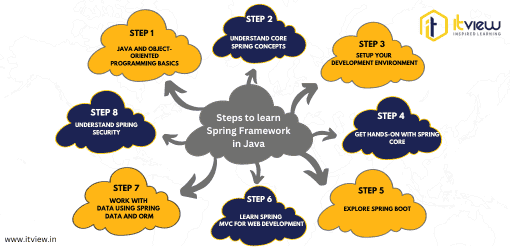The Spring Framework is a versatile and robust application framework for Java, renowned for its extensive capabilities in enterprise application development. Developed by Pivotal Software, Spring simplifies Java development by providing comprehensive infrastructure support and modular components.
Key Uses of the Spring Framework in Java:
- Inversion of Control (IoC) Container:
- Spring’s IoC container promotes loosely coupled components by managing object dependencies. This enhances flexibility and simplifies testing and maintenance.
- Aspect-Oriented Programming (AOP):
- AOP in Spring allows developers to modularize cross-cutting concerns like logging and security, improving code modularity and reusability.
- Transactional Support:
- Spring simplifies transaction management, enabling developers to define transactional behavior declaratively. This ensures data integrity and consistency in applications.
- MVC Web Framework:
- Spring MVC facilitates the development of flexible and well-structured web applications following the Model-View-Controller architecture.
- Data Access Frameworks Integration:
- Spring integrates seamlessly with Hibernate, JDBC, and JPA, providing templates and utilities for efficient database operations.
- Integration with Other Frameworks:
- Spring integrates with various Java EE technologies, messaging systems (e.g., JMS), and scheduling frameworks like Quartz.
- Testing Support:
- Spring’s features such as dependency injection and mock objects facilitate unit and integration testing, ensuring high test coverage and application reliability.
Modular Architecture of the Spring Framework:
The Spring Framework offers a modular architecture with key modules like Core Container, AOP, JDBC, ORM, Web, Test, Security, and Boot. This modular approach allows developers to select and use only the necessary components, promoting flexibility and efficient application development.
Advantages of Using the Spring Framework:
- Simplified Development: Spring reduces complexity with its cohesive framework and promotes best practices like dependency injection.
- Flexibility and Extensibility: Developers can extend functionality by integrating Spring with Hibernate and other frameworks and technologies.
- Community Support: As an open-source framework, Spring benefits from a large and active community, providing extensive resources and support.
In summary, the Spring Framework empowers Java developers to build scalable and maintainable enterprise applications efficiently, leveraging its powerful features and modular design.
How to Learn Spring Framework in Java
Learning the Spring Framework is a valuable skill for Java developers looking to build robust and scalable applications efficiently. Spring offers a comprehensive suite of tools and features that streamline development, promote best practices, and integrate seamlessly with various Java technologies.
Here’s a step-by-step guide on how to effectively learn spring framework in java:
1. Java and Object-Oriented Programming Basics:
- Before diving into Spring, ensure you have a solid understanding of Java programming fundamentals and object-oriented concepts. This includes classes, objects, inheritance, polymorphism, and interfaces.
Join our Java classes in Pune with Placement for basics programming
2. Understand Core Spring Concepts:
- Familiarize yourself with the foundational concepts of Spring such as Inversion of Control (IoC), Dependency Injection (DI), and Aspect-Oriented Programming (AOP). These concepts form the backbone of Spring and are crucial for understanding how Spring simplifies Java development.
3. Setup Your Development Environment:
- Install Java Development Kit (JDK) and Integrated Development Environment (IDE) like IntelliJ IDEA or Eclipse. Spring applications are typically developed using Maven or Gradle as build tools.
4. Get Hands-on with Spring Core:
- Start with the Spring Core module, which includes IoC container and DI. Create simple applications to understand how Spring manages beans (objects) and injects dependencies.
5. Explore Spring Boot:
- Spring Boot makes it easy to create stand-alone, production-grade Spring-based applications. Learn how to use Spring Boot starters, auto-configuration, and externalized configuration to rapidly develop Spring applications with minimal setup.
6. Learn Spring MVC for Web Development:
- Spring MVC is a powerful framework for building web applications. Learn how to configure controllers, handle requests, manage views (JSP, Thymeleaf), and integrate with front-end technologies like HTML, CSS, and JavaScript.
7. Work with Data Using Spring Data and ORM:
- Spring Data simplifies database access and integrates with popular Object-Relational Mapping (ORM) frameworks like Hibernate and JPA. Learn how to define repositories, perform CRUD operations, and leverage Spring’s transaction management capabilities.
8. Understand Spring Security:
- Security is a critical aspect of any application. Learn how to configure authentication and authorization using Spring Security. Understand concepts like authentication providers, user roles, and securing REST endpoints.
9. Explore Advanced Topics:
- Once comfortable with the basics, explore advanced topics such as Spring RESTful web services (Spring WebFlux), microservices architecture with Spring Cloud, messaging with Spring Integration, and batch processing with Spring Batch.
10. Practice and Build Projects:
- The best way to solidify your understanding is through hands-on practice. Build small to medium-sized projects using Spring to apply what you’ve learned. Experiment with different modules and integrate them to understand how they work together.
Ready to Master the Spring Framework?
Take your Java skills to the next level with expert-led courses at ITView. Our comprehensive Java training includes in-depth Spring Framework modules, hands-on projects, and guidance from industry professionals. Start your journey towards becoming a proficient Spring developer today!
Enroll now at Itview Full Stack Java Developer Course to learn it in detail

